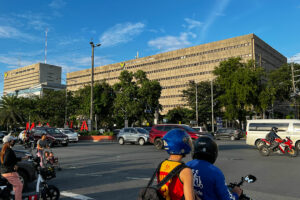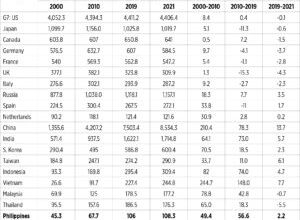Any rate cuts before Fed may hurt peso

By Keisha B. Ta-asan, Reporter
THE PHILIPPINE central bank should cut borrowing costs at an off-cycle meeting before April to support consumer spending and investments, an economist said at the weekend, but others said any rate cuts before the US Federal Reserve starts its own easing could hurt the peso.
The Bangko Sentral ng Pilipinas (BSP) should have started cutting interest rates by 25 basis points (bps) last week to ease the effect of tight policy on consumption and investment, Enrico P. Villanueva, a senior economics lecturer at the University of the Philippines Los Baños, said.
“BSP’s mandate is not to quell inflation at all costs,” he said in a text message. “It is to promote price stability that is supportive of sustainable growth and employment. With more favorable data coming in, I hope BSP would start even a small rate cut at its next meeting, or even at an off-cycle meeting.”
After emerging as the most aggressive central bank in the region, the BSP kept the key rate at 6.5% — the highest in nearly 17 years — for a third straight meeting at its first policy review of the year.
The Monetary Board hiked borrowing costs by 450 bps from May 2022 to October 2023 to tame inflation and help support the peso against the dollar.
“I think BSP is being more conservative than its risk-adjusted inflation forecast,” Mr. Villanueva said. “That conservatism comes at a price.”
Last week, the BSP lowered its risk-adjusted inflation forecast for this year to 3.9% from 4.2% but raised its outlook for 2025 to 3.5% from 3.4%.
The central bank also cut its baseline inflation forecast for this year to 3.6% from 3.7% but kept its projection for 2025 at 3.2%.
“The most telling fact is that BSP itself states that its own risk-adjusted inflation forecast is already within target,” Mr. Villanueva said. “Risk-adjusted forecast is the extreme worse scenario compared with the baseline. This is a strong basis to begin rate cuts.”
BSP’s decision to keep rate steady last week reflects worries of inflationary pressures globally, Cid L. Terosa, a senior economist at the University of Asia and the Pacific (UA&P), said in an e-mail.
“Although domestic inflation has toned down in many countries including the Philippines, external pressures such as disruptions in trade routes and geopolitical tensions in Asia, the Middle East and Europe continue to bolster the possibility of inflationary pressures overflowing to many countries,” he said.
Inflation eased to its lowest in three years to 2.8% in January from 3.9% in December and 8.7% a year ago. It was the second straight month that inflation was within BSP’s 2-4% target.
‘PLAY IT SAFE’The central bank will likely remain cautious before easing rates, Robert Dan J. Roces, chief economist at Security Bank Corp., said in a Viber message. “Base effects, elevated rice prices and potential minimum wage hikes could still threaten the rosy picture.”
Central bank officials earlier said inflation might pick up to more than 4% next quarter due to base effects, before it slows down again in the second half.
Despite the three-year low January inflation figure, rice inflation continued to accelerate to 22.6% from 19.6% in December, the highest since March 2009.
Rice was also the most significant contributor to January inflation, adding 1.3 percentage points. The commodity had the biggest weight in the overall inflation basket at 8.87%.
The House of Representatives is seeking to pass an across-the-board wage increase of as much as P400 for workers in the private sector, higher than the Senate’s P100 proposal.
Mr. Roces said the spike in US inflation in January has pushed market expectations of Fed rate cuts, with the US central bank likely to cut policy rates midyear.
“Locally, tight national savings and a wide current account deficit make pre-Fed cuts risky for the BSP,” he said. “Meanwhile, a robust gross domestic product and rising credit growth give the BSP room to wait.”
US inflation rose by 0.3% month on month in January after increasing by 0.2% in December. Inflation was 3.1% annually, slower than 3.4% in December. Economists polled by Reuters had forecast inflation at 0.2% on the month and 2.9% yearly.
Policy makers from the US Federal Reserve had said they want convincing evidence that inflation is on a sustained downward trend before they consider cutting borrowing costs. The Fed raised its policy rate by 525 bps to 5.25-5.5% from March 2022 to July 2023.
“We expect both the Fed and BSP to ease rates later this year, but BSP will likely play it safe and follow the Fed’s lead,” Mr. Roces said.
Ryota Abe, an economist from Sumitomo Mitsui Banking Corp. (SMBC), said in a note maintaining the 100-bp interest rate differential with the Fed would prevent the peso from depreciating.
“Many market participants now expect the Fed to start cutting rates in the second quarter of 2024,” he said. “If BSP cuts rates by 25 bps every meeting starting at the June 27 meeting, it could cut rates by 100 bps this year.”
The BSP may not cut rates before the fourth quarter, assuming the Fed’s easing cycle starts a quarter earlier, ANZ Research economists Debalika Sarkar and Sanjay Mathur said in a separate note.
“BSP needs to remain patient with its current monetary policy setting amid double-digit consumer credit growth, renewed current account pressures and still-elevated household inflation expectations,” they said. “Our year-end 2024 policy rate forecast of 6% assumes a 50-bp rate cut in the last quarter of 2024.”
The BSP will hold its next policy review on April 4.




